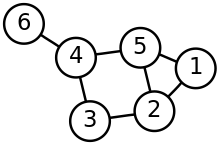Vertex (graph theory)
This article includes a list of general references, but it lacks sufficient corresponding inline citations. (February 2014) |

In
From the point of view of graph theory, vertices are treated as featureless and indivisible objects, although they may have additional structure depending on the application from which the graph arises; for instance, a semantic network is a graph in which the vertices represent concepts or classes of objects.
The two vertices forming an edge are said to be the endpoints of this edge, and the edge is said to be incident to the vertices. A vertex w is said to be adjacent to another vertex v if the graph contains an edge (v,w). The
Types of vertices

The degree of a vertex, denoted 𝛿(v) in a graph is the number of edges incident to it. An isolated vertex is a vertex with degree zero; that is, a vertex that is not an endpoint of any edge (the example image illustrates one isolated vertex).[1] A leaf vertex (also pendant vertex) is a vertex with degree one. In a directed graph, one can distinguish the outdegree (number of outgoing edges), denoted 𝛿 +(v), from the indegree (number of incoming edges), denoted 𝛿−(v); a source vertex is a vertex with indegree zero, while a sink vertex is a vertex with outdegree zero. A simplicial vertex is one whose neighbors form a clique: every two neighbors are adjacent. A universal vertex is a vertex that is adjacent to every other vertex in the graph.
A
A graph is
Vertices in graphs are analogous to, but not the same as,
See also
References
- ^ File:Small Network.png; example image of a network with 8 vertices and 10 edges
- Gallo, Giorgio; Pallotino, Stefano (1988). "Shortest path algorithms". Annals of Operations Research. 13 (1): 1–79. S2CID 62752810.
- Berge, Claude, Théorie des graphes et ses applications. Collection Universitaire de Mathématiques, II Dunod, Paris 1958, viii+277 pp. (English edition, Wiley 1961; Methuen & Co, New York 1962; Russian, Moscow 1961; Spanish, Mexico 1962; Roumanian, Bucharest 1969; Chinese, Shanghai 1963; Second printing of the 1962 first English edition. Dover, New York 2001)
- ISBN 0-486-24775-9.
- Biggs, Norman; Lloyd, E. H.; Wilson, Robin J. (1986). ISBN 0-19-853916-9.
- ISBN 0-201-41033-8.
- Harary, Frank; Palmer, Edgar M. (1973). Graphical enumeration. New York, Academic Press. ISBN 0-12-324245-2.
